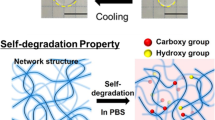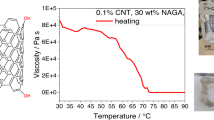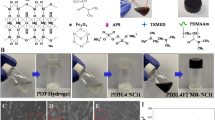Abstract
Organic nanotubes (ONTs) have attracted growing attention in biomedical applications because of their unique inner and outer nanospaces. Here, ONTs were functionalized and hybridized with poly(ethylene glycol) (PEG) to construct nanocomposite hydrogels, with the aim of enhancing their mechanical strength and controlling their release properties. These nanoengineered hydrogels have 4-fold greater mechanical stiffness than unreinforced hydrogels and show a more stable network. The effects of ONT concentration and crosslinkable site density on the hydrogel mechanical properties were systematically assessed. Moreover, the incorporation of ONTs enabled simple and effective post-loading of the model drug, as well as a sustained drug release profile from the hydrogels. These results provide a novel method to generate mechanically enhanced nanocomposite hydrogels with improved drug delivery in an easy, efficient and tunable manner, and the obtained nanocomposite hydrogels may have potential applications in drug delivery and other related bioapplications.
This is a preview of subscription content, access via your institution
Access options
Subscribe to this journal
Receive 12 print issues and online access
$259.00 per year
only $21.58 per issue
Buy this article
- Purchase on Springer Link
- Instant access to full article PDF
Prices may be subject to local taxes which are calculated during checkout










Similar content being viewed by others
References
Guo Y, Bae J, Fang Z, Li P, Zhao F, Yu G. Hydrogels and hydrogel-derived materials for energy and water sustainability. Chem Rev. 2020;120:7642–707.
Mandal A, Clegg JR, Anselmo AC, Mitragotri S. Hydrogels in the clinic. Bioeng Transl Med. 2020;5:e10158.
Aswathy SH, Narendrakumar U, Manjubala I. Commercial hydrogels for biomedical applications. Heliyon. 2020;6:e03719.
Cai P, Chen X. Hydrogels for artificial vitreous: from prolonged substitution to elicited regeneration. ACS Mater Lett. 2019;1:285–9.
Gaharwar AK, Peppas NA, Khademhosseini A. Nanocomposite hydrogels for biomedical applications. Biotechnol Bioeng. 2014;111:441–53.
Li J, Weber E, Guth-Gundel S, Schuleit M, Kuttler A, Halleux C. et al. Tough composite hydrogels with high loading and local release of biological drugs. Adv Healthc Mater. 2018;7:1701393.
Kerativitayanan P, Carrow JK, Gaharwar AK. Nanomaterials for engineering stem cell responses. Adv Healthc Mater. 2015;4:1600–27.
Gong JP. Why are double network hydrogels so tough? Soft Matter. 2010;6:2583–90.
Gao J, Tang C, Elsawy MA, Smith AM, Miller AF, Saiani A. Controlling self-assembling peptide hydrogel properties through network topology. Biomacromolecules. 2017;18:826–34.
Yuan Y, Chesnutt B, Utturkar G, Haggard W, Yang Y, Ong J. et al. The effect of cross-linking of chitosan microspheres with genipin on protein release. Carbohydr Polym. 2007;68:561–7.
Kim H-J, Zhang K, Moore L, Ho D. Diamond nanogel-embedded contact lenses mediate lysozyme-dependent therapeutic release. ACS Nano. 2014;8:2998–3005.
Lavrador P, Esteves MR, Gaspar VM, Mano JF. Stimuli-responsive nanocomposite hydrogels for biomedical applications. Adv Funct Mater. 2021;31:2005941.
Rafieian S, Mirzadeh H, Mahdavi H, Masoumi ME. A review on nanocomposite hydrogels and their biomedical applications. Sci Eng Composite Mater. 2019;26:154–74.
Cirillo G, Hampel S, Spizzirri UG, Parisi OI, Picci N, Iemma F. Carbon nanotubes hybrid hydrogels in drug delivery: a perspective review. BioMed Res Int. 2014;2014:825017.
Wong BS, Yoong SL, Jagusiak A, Panczyk T, Ho HK, Ang WH. et al. Carbon nanotubes for delivery of small molecule drugs. Adv Drug Deliv Rev. 2013;65:1964–2015.
Gangrade A, Mandal BB. Injectable carbon nanotube impregnated silk based multifunctional hydrogel for localized targeted and on-demand anticancer drug delivery. ACS Biomater Sci Eng. 2019;5:2365–81.
Ribeiro JS, Bordini EAF, Ferreira JA, Mei L, Dubey N, Fenno JC. et al. Injectable MMP-responsive nanotube-modified gelatin hydrogel for dental infection ablation. ACS Appl Mater Interfaces. 2020;12:16006–17.
Kameta N, Minamikawa H, Masuda M. Supramolecular organic nanotubes: how to utilize the inner nanospace and the outer space. Soft Matter. 2011;7:4539–61.
Shimizu T, Ding W, Kameta N, Soft-Matter. Nanotubes: a platform for diverse functions and applications. Chem Rev. 2020;120:2347–407.
Valéry C, Artzner F, Paternostre M. Peptide nanotubes: molecular organisations, self-assembly mechanisms and applications. Soft Matter. 2011;7:9583–94.
Komatsu T. Protein-based nanotubes for biomedical applications. Nanoscale. 2012;4:1910–8.
Shimizu T, Minamikawa H, Kogiso M, Aoyagi M, Kameta N, Ding W. et al. Self-organized nanotube materials and their application in bioengineering. Polym J. 2014;46:831–58.
Meilander NJ, Pasumarthy MK, Kowalczyk TH, Cooper MJ, Bellamkonda RV. Sustained release of plasmid DNA using lipid microtubules and agarose hydrogel. J Controlled Release. 2003;88:321–31.
Kameta N, Yoshida K, Masuda M, Shimizu T. Supramolecular nanotube hydrogels: remarkable resistance effect of confined proteins to denaturants. Chem Mater. 2009;21:5892–8.
Son KH, Lee JW. Synthesis and characterization of poly (Ethylene Glycol) based thermo-responsive hydrogels for cell sheet engineering. Materials. 2016;9:854.
Ding W, Wada M, Minamikawa H, Kameta N, Masuda M, Shimizu T. Cisplatin-encapsulated organic nanotubes by endo-complexation in the hollow cylinder. Chem Commun. 2012;48:8625–7.
Lim TM, Ulaganathan M, Yan Q. Chapter 14 - Advances in membrane and stack design of redox flow batteries (RFBs) for medium- and large-scale energy storage. In Advances in batteries for medium and large-scale energy storage, Menictas C, Skyllas-Kazacos M, Lim TM. Eds. Woodhead Publishing: 2015; pp 477–507.
Mukhopadhyay P, Sarkar K, Bhattacharya S, Bhattacharyya A, Mishra R, Kundu P. pH sensitive N-succinyl chitosan grafted polyacrylamide hydrogel for oral insulin delivery. Carbohydr Polym. 2014;112:627–37.
Ding W, Minamikawa H, Kameta N, Shimizu T, Masuda M. Effects of PEGylation on the physicochemical properties and in vivo distribution of organic nanotubes. Int J Nanomed. 2014;9:5811–23.
Ding W, Kameta N, Minamikawa H, Wada M, Shimizu T, Masuda M. Hybrid organic nanotubes with dual functionalities localized on cylindrical nanochannels control the release of doxorubicin. Adv Healthc Mater. 2012;1:699–706.
Das R, Kumar R, Banerjee SL, Kundu P. Engineered elastomeric bio-nanocomposites from linseed oil/organoclay tailored for vibration damping. RSC Adv. 2014;4:59265–74.
Ghosh R, Misra A. Tailored viscoelasticity of a polymer cellular structure through nanoscale entanglement of carbon nanotubes. Nanoscale Adv. 2020;2:5375–83.
Gaharwar AK, Patel A, Dolatshahi-Pirouz A, Zhang H, Rangarajan K, Iviglia G. et al. Elastomeric nanocomposite scaffolds made from poly (glycerol sebacate) chemically crosslinked with carbon nanotubes. Biomater Sci. 2015;3:46–58.
Shah K, Vasileva D, Karadaghy A, Zustiak S. Development and characterization of polyethylene glycol–carbon nanotube hydrogel composite. J Mater Chem B. 2015;3:7950–62.
Acknowledgements
This work was supported by a KAKENHI from the Japan Society for the Promotion of Science (grant no. JP18K09469).
Author information
Authors and Affiliations
Contributions
D. Wu and W. Ding conceived and planned the experiments. D. Wu took the lead in conducting the experiments, analyzing the data and writing the mannuscript. W. Ding contributed to the final version of the manuscript. N. Kameta commented on the manuscript writing.
Corresponding author
Ethics declarations
Conflict of interest
The authors declare no competing interests.
Additional information
Publisher’s note Springer Nature remains neutral with regard to jurisdictional claims in published maps and institutional affiliations.
Supplementary information
Rights and permissions
About this article
Cite this article
Wu, D., Ding, W. & Kameta, N. Functionalized organic nanotubes with highly tunable crosslinking site density for mechanical enhancement and pH-controlled drug release of nanocomposite hydrogels. Polym J 54, 67–78 (2022). https://doi.org/10.1038/s41428-021-00556-1
Received:
Revised:
Accepted:
Published:
Issue Date:
DOI: https://doi.org/10.1038/s41428-021-00556-1
This article is cited by
-
Organic nanotubes for smart anticorrosion and antibiofouling coatings
npj Materials Degradation (2022)



